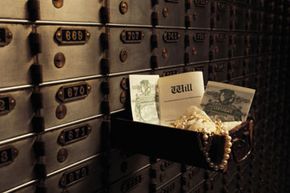Advanced Fixes and Photo Storage
One-click photo fixes are wondrous to behold. However, with pictures that have any significant damage, you'll eventually have to pull out more powerful features like the healing brush tool.
With this tool, you can paint over cracks or blemishes and watch them disappear, but you'll have to experiment with brush size, opacity and hardness before you achieve just the right look. This brush uses advanced software algorithms to analyze color and detail adjacent to the area you want to repair, and it restores similar tones and details to the damaged portion.
Advertisement
You may also want to experiment with the clone stamp tool. This tool lets you manually copy a portion of the image and then stamp the same pattern or color to parts of the image that are in disrepair. Like the healing brush, this tool takes some practice to master. You can make things easier for yourself by magnifying the area you're working on. Save often and give yourself breaks if the work becomes frustrating.
Image-editing programs such as these take a bit of practice to learn. Fortunately, if you search for tutorials on the Internet, you'll find all sorts of advice and specific instructions for fixing old photos.
Once you've fixed a photo and made new prints, it only makes sense to store them properly. Extreme temperatures and humidity, along with light, water and insects, destroy many pictures.
You'll want to store your pictures in a rigid box in a dark location at a temperature of 70 degrees, with relative humidity of 35 percent. A tough plastic box with a hard lid can do the trick, but, for maximum protection, a fireproof box is an even better bet for long-term storage. The downside is that quality safes cost hundreds of dollars.
If you don't want to drop that much cash on a safe, consider a safe-deposit box at your local bank. You won't have immediate access to your pictures at all times, but the big benefit is that your precious photos are about as safe as they can be.
Picture restoration projects can be very time-consuming, but they're also very rewarding. Once you practice your techniques on a few images, you'll see how just a bit of editing can reap huge dividends in the form of improved picture quality. And in the end, you'll have the satisfaction of knowing that you're helping to retain important parts of your family's history, too.
Related Articles
- 5 Tips for Scanning Old Photos
- 5 Tools for Digital Photo Albums
- 5 Things You Should Never Do With Family Photos
- How should you catalog your family photos?
Sources
- American Institute for Conservation of Historic and Artistic Works. "Caring for Your Treasures." Conservation-us.org. (Feb. 28, 11)http://www.conservation-us.org/index.cfm?fuseaction=Page.viewPage&pageId=633&parentID=497
- Genealogy. "Protecting Family Memories from Time." Geneaology.com. (Feb. 28, 2011)http://www.genealogy.com/genealogy/10_prsrv.html
- Hendriks, Klaus B. "The Preservation and Restoration of Photographic Materials in Archives and Libraries: A Ramp Study with Guidelines." United Nations Educational, Scientific, and Cultural Organization." January 1984. (Feb. 28, 2011)http://unesdoc.unesco.org/images/0005/000586/058641e.pdf
- Library of Congress. "Care, Handling, and Storage of Photographs." Loc.gov. October 18, 2006. (Feb. 28, 2011.)http://www.loc.gov/preserv/care/photolea.html
- Mishkin, David L. "Restoring Damaged Photographs." Geneaology.com. (Feb. 28, 2011)http://www.genealogy.com/genealogy/10_restr.html
- Moorshead, Halvor. "Scanners and Scanning." Geneaology.com. (Feb. 27, 2011)http://www.genealogy.com/genealogy/61_chronicle.html
- National Archives. "How Should I Store My Photographic Prints?" Archives.gov. (Feb. 26, 2011)http://www.archives.gov/preservation/family-archives/storing-photos.html
- National Archives. "Should I Digitize My Photo Collection? Is it Safe to Throw Away My Original Film and Prints After I Digitize Them?" Archives.gov. (Feb. 27, 2011)http://www.archives.gov/preservation/family-archives/digitizing-photos.html
- Parraman, Carinna and Rizzi, Alessandro. "Spatial Image Processing for the Enhancement and Restoration of Film, Photography, and Print." (Feb. 26, 2011)http://westengland.academia.edu/CarinnaParraman/Papers/271514/Spatial_image_processing_for_the_enhancement_and_restoration_of_film_photography_and_print
- Thackray, M. "Autoradiography of Radioactive Photographic Images - Applications to Intensification, Restoration, Precision Etching, Photomechanical Reproduction and Photographic Research." Australian Atomic Energy Commission." (Feb. 26, 2011)http://apo.ansto.gov.au/dspace/bitstream/10238/518/1/AAEC-E-317.pdf
- Vezina, Andrew. "Restoring Your Old Photos." Family Chronicle. November/December 1999. (Feb. 26, 2011)http://www.familychronicle.com/RestoringOldPhotos.html
